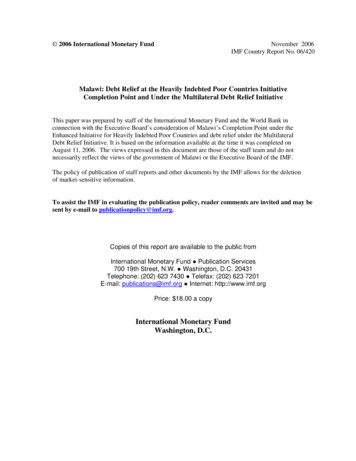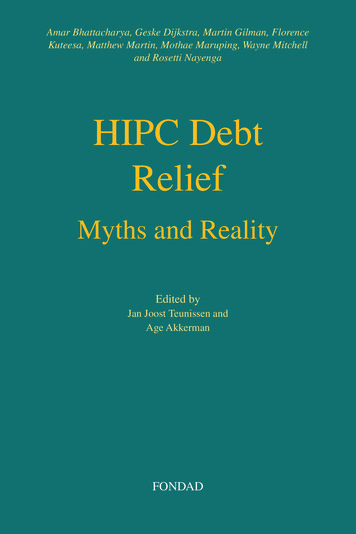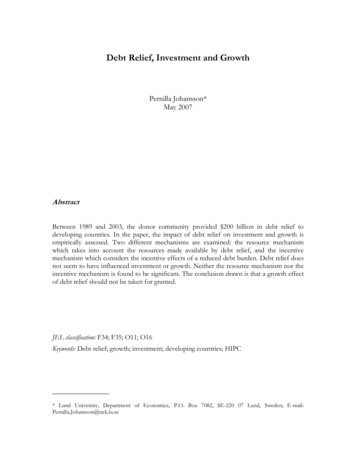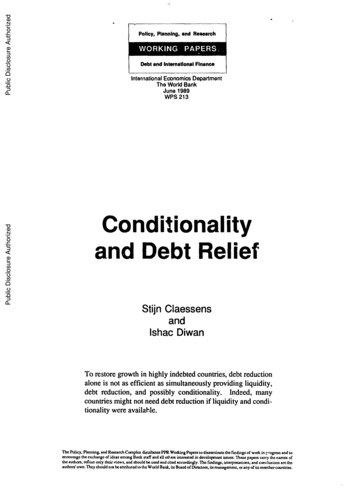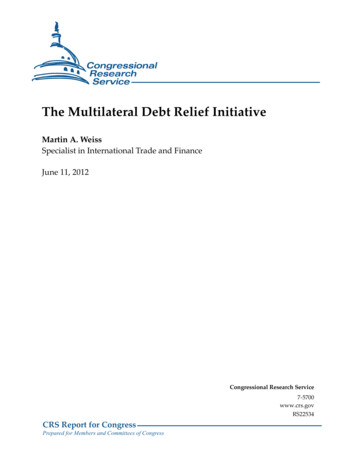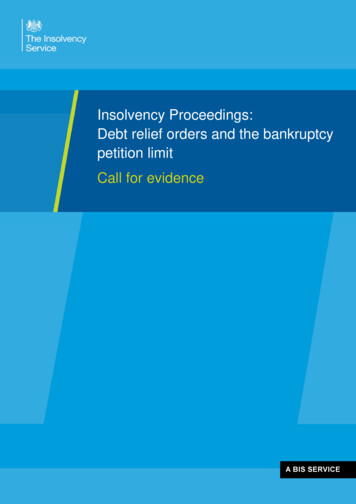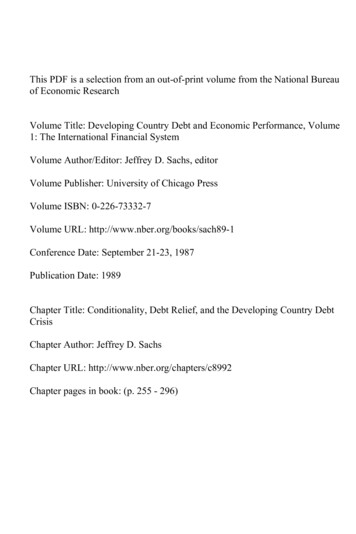
Transcription
This PDF is a selection from an out-of-print volume from the National Bureauof Economic ResearchVolume Title: Developing Country Debt and Economic Performance, Volume1: The International Financial SystemVolume Author/Editor: Jeffrey D. Sachs, editorVolume Publisher: University of Chicago PressVolume ISBN: 0-226-73332-7Volume URL: http://www.nber.org/books/sach89-1Conference Date: September 21-23, 1987Publication Date: 1989Chapter Title: Conditionality, Debt Relief, and the Developing Country DebtCrisisChapter Author: Jeffrey D. SachsChapter URL: http://www.nber.org/chapters/c8992Chapter pages in book: (p. 255 - 296)
6Conditionality, Debt Relief,and the Developing CountryDebt CrisisJeffrey D. Sachs6.1 IntroductionThis chapter examines the role of high-conditionality lending by theInternational Monetary Fund and the World Bank as a part of theoverall management of the debt crisis. High-conditionality lending refers to the process in which the international institutions make loansbased on the promise of the borrowing countries to pursue a specifiedset of policies. High-conditionality lending by both institutions hasplayed a key role in the management of the crisis since 1982, thoughthe results of such lending have rarely lived up to the advertised hopes.One major theme of this chapter is that the role for high-conditionalitylending is more restricted than generally believed, since the efficacyof conditionality is inherently limited.A related theme is that many programs involving high-conditionalitylending could be made more effective by including commercial bankdebt relief as a component of such programs. I shall argue that suchdebt relief can be to the benefit of the creditor banks as well as thedebtors, by enhancing the likelihood that the debtor governments willadhere to the conditionality terms of the IMF and World Bank loans,and thereby raise their long-term capacity to service their debts.Almost by definition, countries in debt crisis that appeal to the Fundor the Bank for new loans have already been judged to be uncreditworthy on normal market criteria. In such treacherous circumstances,it is appropriate to ask why the IMF or the World Bank should beextending new loans. As an alternative, for example, the internationalinstitutions could allow the creditors and debtors to renegotiate newJeffrey D. Sachs is a professor of economics at Harvard University and a researchassociate of the National Bureau of Economic Research.255
256Jeffrey D. Sachsterms on the old loans without any official involvement. Such twoparty negotiations between creditors and debtors characterized earlierdebt crises, before the IMF and World Bank existed (see Lindert andMorton, chap. 2 in this volume, for a discussion of the earlier history).In principle, continued lending by the international institutions couldbe justified by several nonmarket criteria: as a form of aid, as aninvestment by the creditor governments that finance the IMF and WorldBank in political and economic stability of the debtor country (see VonFurstenberg 1985a; 1985b, for such a view), as an extension of theforeign policy interests of the major creditor governments, as a defenseof the international financial system, etc. Loans are not usually defended on these grounds, though in fact such considerations are frequently important. Of course, these criteria are valid to an extent, butalso extremely difficult to specify with precision as a basis for IMFWorld Bank lending.Another defense of lending, also with considerable merit in somecircumstances, is that the IMF (and World Bank to a far lesser extent),can act as a “lender of last resort,” analogous to a central bank in adomestic economy. The theory of the “lender of last resort” is notfully developed, though the practical importance of having a domesticlender of last resort is not much in dispute. The conceptual argumentgoes something as follows.Commercial banks are at a risk of self-confirming “speculative panics” by their depositors because the banks engage in maturity transformation of their liabilities, i.e., they borrow short term and lend longterm (see Diamond and Dybvig 1983 for a formal model of bankingpanics). If the depositors suddenly get the idea that all other depositorsare going to withdraw their funds, it is rational for each depositor towithdraw his own funds from the bank, even if the bank would befundamentally sound in the absence of a sudden rush of withdrawals.The depositors’ collective behavior creates a liquidity crisis for thebank, in that a fundamentally sound intermediary cannot satisfy thesudden desire of its depositors to convert their deposits to cash. Alender of last resort, usually the central bank, can eliminate the liquiditycrisis by lending freely to the bank in the short term. The banking panicis a form of market failure, that can be overcome by a lender of lastresort.The analogous argument for the IMF would hold that the privatecommercial bank lenders to a country might similarly panic, and alldecide to withdraw their funds from the country even though the country is a fundamentally sound credit risk in the longer term (see Sachs1984 for such a model). In this case, lending by the IMF can eliminatethe liquidity squeeze on the country, and thereby help both the creditorsand the debtors. As in the domestic economy, the IMF helps to overcome a well-defined market failure.
257Conditionality, Debt Relief, and the Debt CrisisThis argument was part of the basis of the original IMF interventionin the debt crisis of the early 1980s. The argument following the Mexican crisis in mid-1982 was that countries were suffering from a liquiditycrisis, made acute by the simultaneous rise in world interest rates andthe sudden cessation of commercial bank lending. It seemed at the timethat the crisis could be quickly resolved (as argued, for example, byCline 1984), since it represented merely a liquidity squeeze.The liquidity arguments are no doubt true in some cases, but mostobservers now doubt that the developing country debt crisis representsmerely a problem of liquidity. Six years after the onset of the crisis,almost no countries have returned to normal borrowing from the international capital markets, and the secondary-market value of bankloans to the debtor countries reflect very deep discounts in valuation.For many countries at least, the crisis represents more fundamentalproblems of solvency and longer-term willingness to pay on the partof the debtor nations.In these circumstances, other justifications (that can be in additionto the liquidity argument) have been advanced for the large role of IMFand World Bank lending, By far the most important argument is thatstrict conditionality attached to IMF-World Bank loans can make suchloans sensible on normal market terms. The assumption is that theinternational institutions are better than the banks at enforcing goodbehavior of the debtor country governments, and therefore have morescope for lending.The importance of conditionality in justifying IMF-World Banklending is certainly well placed. Countries in crisis are often in pooreconomic shape in large part because of bad policy choices in thepast. IMF and World Bank policies are appropriately focused on keypolicy weaknesses (excessive budget deficits in the case of the IMF,and excessive inward orientation in the case of the World Bank).Moreover, the IMF and World Bank have the expertise and institutional clout to design high-conditionality programs, while the commercial banks do not.Nonetheless, the role for high-conditionality lending is overstated,especially in the case of countries in a deep debt crisis. In practice thecompliance of debtor countries with conditionality is rather weak, andthis compliance problem has gotten worse in recent years, since a largestock of debt can itself be an important disincentive to “good behavior.”In other words, the debt overhang itself makes it less likely that conditionality will prove successful.The reason is straightforward. Why should a country adjust if thatadjustment produces income for foreign banks rather than for its owncitizenry? Since deeply indebted countries recognize that much ofeach extra dollar of export earnings get gobbled up in debt servicing,a very large stock of debt acts like a high marginal tax on successful
258Jeffrey D. Sachsadjustment. Therefore, two counterintuitive propositions could be truewhen a country is deeply indebted: “Good behavior” (such as a higherinvestment rate) can actually reduce national welfare, by increasingthe transfer of income from the debtor country to creditors; and explicit debt relief by the creditors can increase the amounts of actualdebt repayment, by improving the incentive of the debtor country tomake the necessary adjustments.Before turning to these arguments at greater length, we should consider one additional argument sometimes made for official lending. Theargument is occasionally made that since countries are more averse todefaulting on official loans than they are on private loans, it is safe forofficial creditors to lend even when private creditors will not. Thisargument can sometimes be correct, but it is often mistaken. If officialloans just raise the country’s debt burden without raising its debtservicing capacity, then repayments to the official creditors might simply crowd out repayments to its private creditors, and thereby undermine the smooth functioning of the international capital markets.The issues of conditionality and debt relief will be discussed as follows. Section 6.2 outlines the theory of conditionality and section 6.3focuses on the empirical record of high-conditionality lending. Section6.4 shows the linkages between the overhang of debt and the effectiveness of conditionality, and demonstrates the potential role for debtrelief in high-conditionality lending. Section 6.5 then discusses the specific problems raised by the macroeconomic situation of the heavilyindebted countries: high inflation, excessive inward orientation, largebudget deficits, and a prolonged economic downturn, all exacerbatedby the problem of high foreign indebtedness. The recent history ofstabilization has shown that few countries have been able to solve evenone or two of these problems at a time, much less all of them simultaneously, and the record suggests that adjustment programs have thehighest probability of success when macroeconomic stabilization precedes large-scale trade liberalization and a shift to outward orientation.6.2 High-Conditionality Lending by the IMF and World BankThe argument for high-conditionality lending is that the IMF and theWorld Bank can compel countries to undertake stabilizing actions inreturn for loans, thereby making the loans prudent even when theprivate capital markets have declared the country to be uncreditworthy.A full theory of conditionality would have to explain three things. First,if the actions being recommended to the country are really “desirable”for the country, why is it that the country must be compelled to undertake the policy? Second, if the country must indeed be compelledto undertake the actions, what types of force or sanctions could be
259Conditionality, Debt Relief, and the Debt Crisisused to guarantee compliance? And third, why is it that internationalinstitutions are better able to impose conditionality than are the privatecapital markets?One solution to the conundrum of why countries must be compelledto accept conditionality is the problem of “time consistency”: a debtorgovernment accepts ex ante the need for a policy adjustment as thequid pro quo for a loan, but the government has a strong incentive toavoid the policy change once the loan is arranged. In this case, the roleof conditionality is to bind the country to a course of future actions,actions which make sense today but which will look unattractive in thefuture. In other words, the goal of conditionality is to make the ex anteand ex post incentives for adjustment the same (where ex ante and expost are with respect to the receipt of the loan).In earlier papers (Sachs 1984; Cooper and Sachs 1985), I gave a simpleillustration of a case in which conditionality was appropriate. I willdiscuss that case here, relegating the formal model to appendix A.Suppose that a government faces the problem of allocating resourcesbetween consumption and investment. The government has a very hightime-discount rate (0.30 for purposes of illustration), so that currentconsumption is much preferred to future consumption. The investmentopportunities have a return (0.20) in excess of the world interest rate(0.10), but less than the time discount rate.The problem is the following. Once the foreign loans are obtained,and the government has to decide how to allocate over time the totalpool of resources (equal to domestic resources plus foreign borrowing),the government will choose to consume rather than invest. That isbecause its time discount rate exceeds the rate of return on investment,so that it does not pay to sacrifice consumption expenditures in orderto raise investment. For concreteness we suppose that a particularexport-oriented investment project costs 100 million, and thereforeyields 120 million in the future.We assume that without investment the country will not have theresources to pay off a loan in the following period. The government isthen assumed to pay off as much as it can, and to default on the rest.Under these conditions, private foreign lenders will not lend much tothis country since they correctly foresee that the government will notinvest the money. The situation can be depicted simply as a two-stagegame between the creditors and the borrower. The creditor must firstdecide whether to lend; the borrower then decides whether to invest.As illustrated in figure 6.la, once the money is received, the government’s “utility” is higher by consuming today rather than investing(utility is assumed to be equal to consumption, with future consumptiondiscounted by the rate of time preference). In particular, the countrygets 100 in utility by using the loan for current consumption, and then
260Jeffrey D. Sachs(0)The Loan Decision Without Conditionality0tLendertCountryDecisionDecision(L Lend(I lnvestNL Not Lend) NI Not Invest)a-1001030-a0tLenderUtility0 (Equilibrium1tCountryUtility( b l The Loan Decision w i t h ConditionalityI08 (Equilibrium1not applicoble-ao tLenderDecisionFig. 6.1tCountryDecisionnot applicabletLenderUtilitytCountryUtilityLoan market equilibriumdefaulting on the loans, but only 8 if the loan is used for investment.Because the country’s incentive to consume and then default is recognized by potential private creditors, the country is a bad credit risk.Since the loan will not in fact be made, the country’s utility from theloan is of course 0.0 (the arrows indicate the equilibrium choices).On the other hand, if the country could commit itself to increase investment by the amount of the foreign loans, as shown in figure 6. Ib, itwould result in a better outcome for the country specifically, a utility of8 rather than 0.0. (As shown, the lender is indifferent between the twocases, because the lender just gets repaid with zero profit in the case6. lb. In reality, the lender would presumably strictly prefer the case oflending with repayment to the case of no lending.) Since the investment
261Conditionality, Debt Relief, and the Debt Crisisopportunities have a return that is higher than the world cost of borrowing, the returns to the investment will be more than enough to payoff the loans. Moreover, since the investment is foreign financed, undertaking it does not have to reduce current consumption. Thus, if thecountry can commit itself to use foreign loans for investment purposes,the country will (1) maintain current consumption levels and (2) generate out of the investment project more than enough future incomenecessary to repay the debt. In sum, it is advantageous for the government to try to “tie its hands,” and commit itself to use new foreignmoney for investment rather than consumption purposes.The role for conditionality is introduced by assuming that countriescannot make credible, enforceable commitments with private lendersto use loans for one purpose or another, but that by means of conditionality agreements with the IMF or World Bank, the country cancommit itself to a particular investment program. In such a case, itwould be safe for the IMF or World Bank to make high conditionalityloans to the country (since the loans will be used for investment purposes), while it would be imprudent for the private sector to make thesame loans (since without conditionality, the government will consumethe proceeds of the loan rather than invest).The remaining problem with conditionality comes from the fact thatonce the IMF or World Bank lending is received, the country has theincentive to renege on its investment commitment. Given the preferences of the government, it is always better to consume than to investonce a level of foreign loans has been established. Thus, there mustbe some way for the country or the IMF and World Bank to guaranteethat the commitment to invest is actually honored.In practice, bargaining over conditionality almost always involvesmore than the debtor government’s binding itself to a specific path ofpolicies. Bargaining between a debtor country and the IMF and WorldBank may also involve an implicit dispute about which objective function to use in evaluating a set of outcomes. If a program will lead to arecession next year, but a recovery over the following several years,is it desirable? The answer may well be “yes” to the Fund or the Bank(or their creditor governments, which recognize that adjustment mayinvolve short-run pain in return for long-run benefits), but the sameanswer might be “no” to a precarious regime that might lose powerduring a period of austerity. Openness about this difference of opinionwould block the signing of many agreements. In practice, neither theFund or Bank on the one hand nor the creditor government on theother fully admit their disagreements, so that many conditionality packages are signed that have little chance of fulfillment, a point I returnto below.
262Jeffrey D. Sachs6.2.1 Official versus Private Lending in IMF-World Bank PackagesIn the framework just described, the major role for the IMF and theWorld Bank is to guarantee through conditionality that the country willuse a new loan for investment rather than consumption. We have discussed the issue as if the loan itself would come from the monitoringinstitutions, but in fact, there is no reason why there could not insteadbe a division of labor: The international institutions impose the conditionality ; the private capital markets provide the financing. This is awell-recognized idea, that the international institutions should act mainlyto provide “a seal of good housekeeping,” and thereby to catalyzeprivate lending.Since the outbreak of the debt crisis, the IMF and World Bank haveoften emphasized such a catalytic role. One of the major innovationsearly in the crisis was the IMF’s insistence to the commercial banksthat any new IMF program for Mexico would require that the commercial banks commit 5 billion of additional lending to Mexico as well.Thus began the pattern of “involuntary” or “nonspontaneous” banklending, in which the banks agreed to commit new lending to a debtorcountry in proportion to their existing exposures to the country, aspart of an IMF stabilization package. More recently, private cofinancingwith the World Bank has also been added as a condition of somepackage agreements (e.g., the Argentine agreement in 1986).The details of such loan packages are beyond the scope of this chapter, and have been discussed at some length by Sachs and Huizinga(1987). Here it suffices to point out the extremely limited nature ofsuch financing, and that the “catalytic” role of the IMF and WorldBank have been vastly overstated (this may be a result of the lack ofcredibility of the conditionality, for reasons suggested below). Threepoints can be made here. First, overall net bank lending to the problemdebtor countries were negative during 1982-86, not positive. That is,loan amortizations exceeded new lending, even after taking into account all of the well-publicized “concerted lending” arrangement. Theconcerted lending has been sporadic, and small in absolute magnitude,compared with the levels of debt amortizations in recent years. Thus,the levels of commercial bank exposure in the debtor countries actuallyfell after the onset of the crisis.Second, the new lending by the commercial banks, where it hasoccurred, has almost always fallen far short of the debt servicing payments made by the debtor countries to the creditor banks. In this sense,the net resource transfers from the banks to the major debtor countrieshas been highly negative in recent years, despite the occasional application of concerted lending.
263Conditionality, Debt Relief, and the Debt CrisisThird, and perhaps most disturbing, the IMF has not devoted muchenergy to getting concerted lending programs for the smaller debtorcountries, but only for the larger countries (e.g., Argentina, Brazil, andMexico). Almost no debtor country with an outstanding debt below 5 billion has been able to get any concerted lending from its commercial bank creditors, as is shown in table 6 in Sachs and Huizinga(1987). The smaller and politically weaker debtor countries have apparently had to make much larger net resource transfers than have theirlarger fellow debtor countries.6.2.2 Enforcement of Conditionality Agreements: The TheoryThe question of enforcement of conditionality agreements is in manyways tougher than the question of why conditionality is needed. Thejustification for IMF-World Bank lending rests on two propositionsregarding enforcement: (1) that the enforcement of IMF-World Bankconditionality is sufficiently powerful to result in an “acceptable” rateof compliance with IMF-World Bank programs and (2) that the officialinstitutions have an advantage over the commercial banks in enforcingconditionality. In both this section and the next, I examine the validityof these views.6.2.3 The Strength of ConditionalityFor both the international institutions and the commercial banks, thelegal bases of conditionality are weak. In the domestic capital markets,bond covenants are legally binding restrictions on the behavior of debtors, which can generally be enforced with only modest transactioncosts. In the international arena, particularly for loans to sovereigngovernments, the transaction costs for enforcing loan agreements areextremely high. As most writers have recognized recently, the mainmethod of enforcement for lenders (whether official or private) involvesthe threat of cutoffs of new loans to misbehaving borrowers. Such acutoff in lending can of course be extremely disruptive and costly toa borrower. Bank creditors can cut back on short-term trade creditsto a country, and thereby disrupt the flow of international trade in theshort term. The IMF similarly can cut back on balance-of-paymentssupport, and by doing so, also trigger the cutoff of lending from otherofficial sources (e.g., the World Bank, the bilateral official creditors,the multilateral development banks).Theoretical work and empirical evidence both establish that the threatof a lending cutoff is a credible, but inherently limited sanction. Thus,conditionality, whether by the IMF and World Bank, or by the commercial banks themselves, should not on an a priori basis be expectedto have the same force as a binding bond covenant in a domestic loan.
264Jeffrey D. SachsFrom the beginning, we should appreciate the inherent limitations ofthe enforcement mechanisms in conditionality on international lending.6.2.4 The Special Problem of Negotiating with a SovereignBorrowerConditionality is limited in effectiveness not only because of enforcement difficulties, but also because of the complexity of negotiatingwith a sovereign borrower. In the case of a bond covenant, there is aclear legal responsibility on the borrower to carry out the conditionsof the covenant. When a government is the debtor, however, there islikely to be a considerable diffusion of power within the government,to the extent that the individual parts of the government negotiatingthe conditionality agreement may well lack the authority to implementthe agreement.This problem is common with IMF agreements, though it is rarelydiscussed or carefully analyzed. The IMF invariably negotiates withthe executive branch, and mainly with a small part of the executivebranch, the finance ministry. A small group of technocrats at the ministry of finance and at the central bank will typically negotiate the IMFagreement in private, and in splendid isolation from the rest of thegovernment. However, when the minister of finance signs the agreement with the Fund, very often there can be little assurance that theminister has the authority or political standing within the governmentto carry out the agreement. This is especially the case when the ministeragrees to spending and tax changes that require parliamentary approval,or that require the approval of other parts of the government (independent state enterprises, regional corporations, state and municipalgovernments, other ministries, etc.). Often, it is the president himselfthat undercuts his finance minister in the execution of an adjustmentprogram.In this sense, most IMF and World Bank agreements start with aformal myth, that there is one unified actor in the government that canbe bound by the terms of a conditionality agreement. This may be anecessary myth, and even sometimes a useful one, but uncovering themyth helps us in a simple way to account for the fact that most IMFagreements fail, a point we shall see below.6.2.5 The Debt Overhang and the Weakness of ConditionalityWhat must also be appreciated is the fact that the current overhangof external debt to private creditors can greatly hinder the effectivenessof IMF conditionality, at least under the prevailing design of IMF programs. Virtually all IMF programs to date have been designed underthe assumption that the debtor country can and will service its externaldebts in the long run on a normal market basis. The programs are
265Conditionality, Debt Relief, and the Debt Crisisconstructed in the expectation of normal debt servicing. (For example,in the technical calculations in Fund programs, interest rates on theexisting debt are assumed to be at market rates; the country is assumedto clear all arrears on a reasonable timetable, etc.)It might easily be the case, however, that a country would be betteroff defaulting on a portion of its debts than it would be with timelydebt servicing (a dozen or more countries had indeed taken such unilateral action by 1987). There simply may not exist an IMF highconditionality program based on full debt servicing, that, if followed,would actually make the country better off than it would be withoutthe program but with a partial suspension of debt payments. In otherwords, the IMF program might be too restrictive relative to the available options of the debtor government.In such circumstances, four things could happen. One outcome wouldbe for the IMF to design a program that is actually based on partialand explicit debt relief. So far, the IMF has avoided this rather obviousapproach, partly because it has underestimated the possible efficiencygains for all parties (creditors, debtors, and the Fund) that might result.The second possibility is that the IMF and the debtor government wouldfail to sign a program, and the country would suspend payments onthe part of its private sector debts. This has been the case with Peruduring 1985-87, and Brazil in 1987. The third possibility, and indeedthe typical case in recent years, is that the Fund and the country wouldsign a program based on full debt servicing, even though both partiesfully expect that the agreement will breakdown in due course. Eitherthe conditionality would be allowed to fall by the wayside and thecountry would continue to borrow from the Fund but without livingup to earlier commitments, or the IMF program would eventually besuspended.Argentina during 1987-88 provides an ideal illustration of the case inwhich the IMF and a debtor country signed a series of agreements inwhich almost no observers had any confidence, and in which the IMFsimply relaxed the conditionality terms (with formal waivers) throughout the course of the agreement. Mr. David Finch, the former directorof the IMF Department of Exchange and Trade Relations, writes of Argentina as a case of “renewed pressures to involve the IMF in an agreement where political solutions [in Argentina] won’t allow a solution tothe balance-of-payments problem. . . . [Tlhe IMF has been forced tocontinue lending [to Argentina] to maintain the facade of the debt strategy.” (Finch, 1988, 127). In less diplomatic language, the U.S. government was fearful that Argentina would default to the commercial banksin the absence of new IMF money. The U.S. therefore pressured theFund to maintain a program with Argentina despite the failure of theArgentine government to live up to earlier agreements.
266Jeffrey D. SachsA fourth possibility would be for the IMF and World Bank to approveprograms with debtor countries that allow for a buildup of arrears (i.e.,nonpayments) to the commercial bank creditors, in well-defined circumstances. These circumstances would include (1) a large overhangof debt that is deemed to be highly inimical to the stabilization effortsof the country and (2) the unwillingness of the commercial creditorseither to grant relief or significant new financing. By allowing for thebuildup of arrears to private creditors, the IMF could design morerealistic programs without the need t
257 Conditionality, Debt Relief, and the Debt Crisis This argument was part of the basis of the original IMF intervention in the debt crisis of the early 1980s. The argument following the Mex- ican crisis in mid-1982 was that countries were suffering from a liquidity crisis, made acute by the simultaneous rise in world interest rates and


